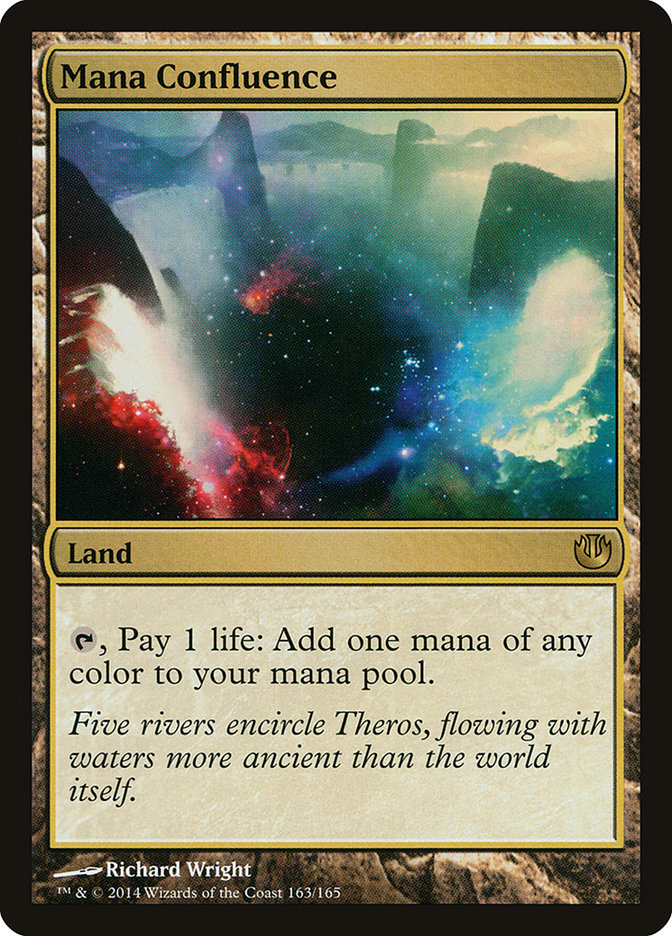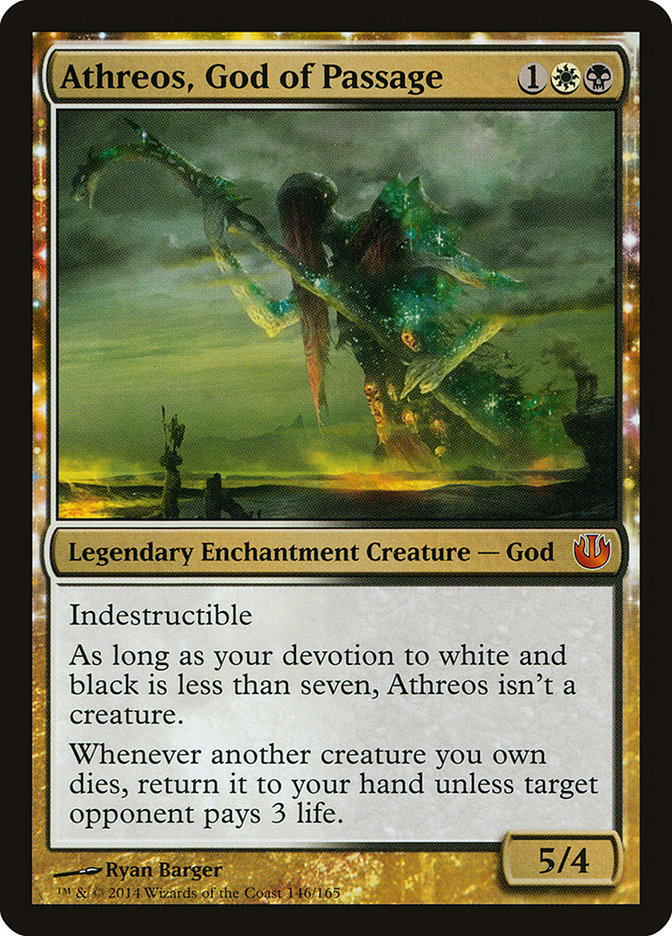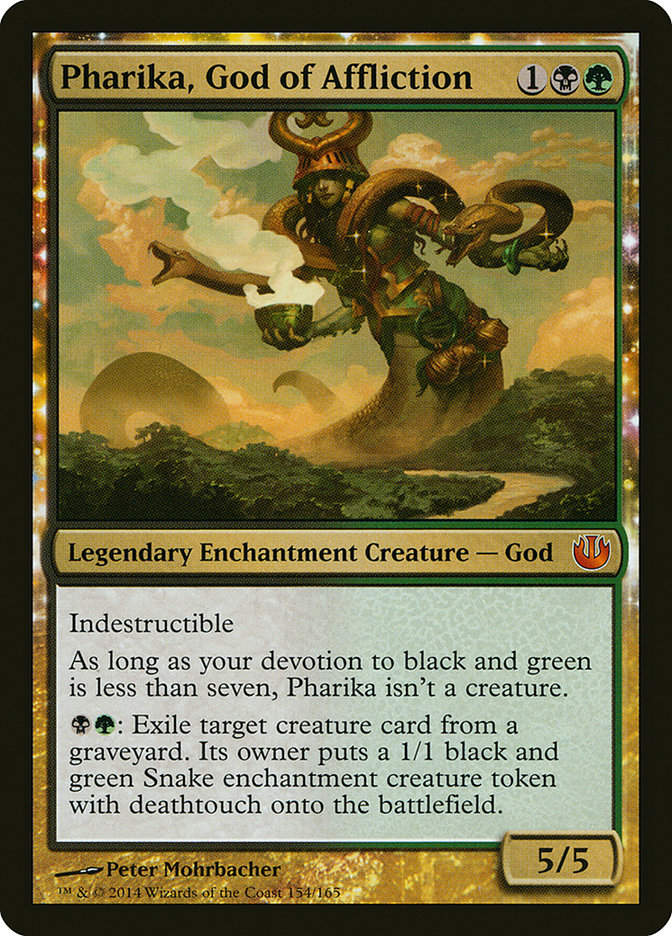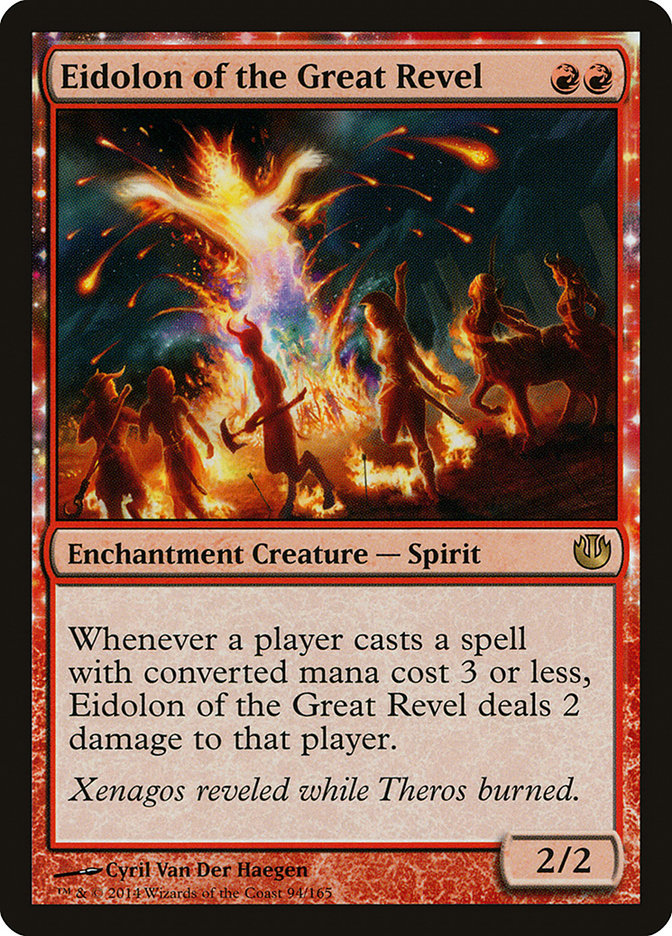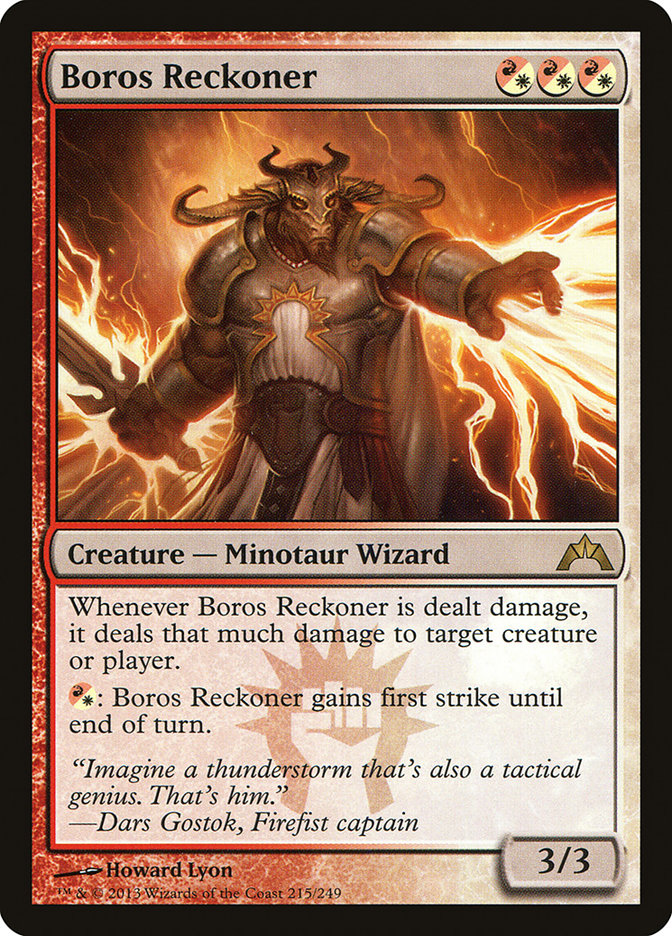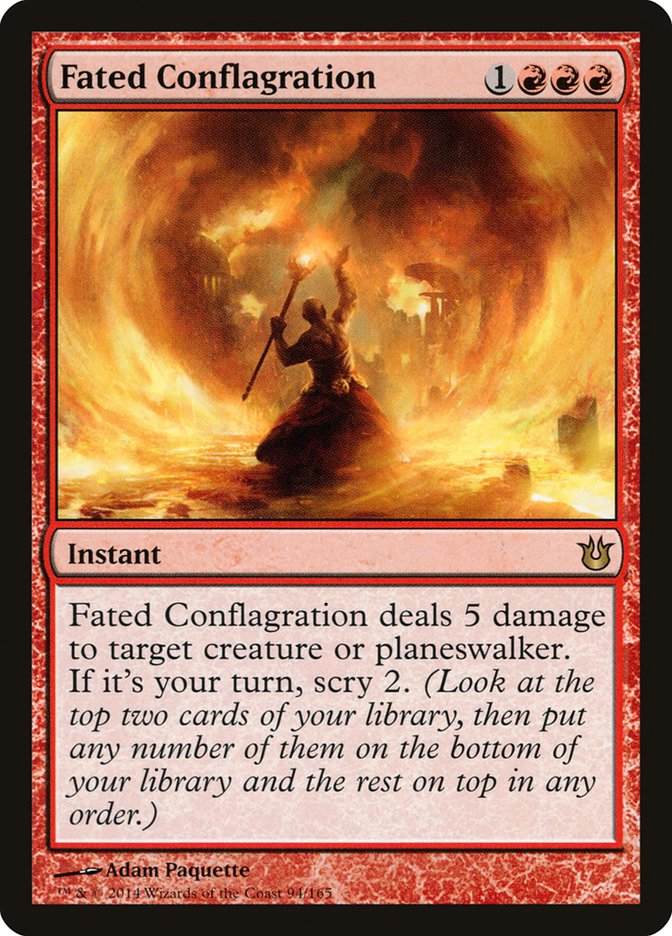By the time you read this, you’ll know more than I know. You’ll know what the entire set looks like. Pro Tour builders will be in a frenzy to pick up the cards they need as they test and build for May’s Pro Tour in Atlanta. Modern and Legacy brewers will be free to pick through the weeds and find the handful of stand-out winners that will take their respective formats to the next level.
This is all great news, but I must admit I’m most excited about Journey into Nyx’s contributions to Standard. A lot of effects that Standard hasn’t seen in a while (or ever) arrive starting next weekend, and the world is abuzz with players’ conjectures on what’s next in the largest Constructed format.
For my part, I feel fairly confident I can tell you what’s next.
“Mana Confluence, go to nineteen, awesome one-drop, go.”
This slightly altered City of Brass is whether we like it or not the absolute center of this set. This greedy land lets you make any mana for the low, low price of a life point. Use it twice and you’re on par with playing a Hallowed Fountain or Overgrown Tomb untapped, and people do that all the time. Managing your life total has always been a part of Magic, and the introduction of this end-all land reminds us how important it is.
As I looked at different existing builds (and a whole bunch of new directions), I realized that I wanted four of these in almost every deck I built. Do yourselves a favor and grab them now. They will be a hot commodity in about four weeks, mark my words. A little bit of playtesting will show you the power of this land. People will want it for Commander and every 60-card format out there for years to come.
Although I said I’d hold off on sharing my brews until after the full set was spoiled, I’m gonna chop away at it now from the past, where only 74/156 cards are officially spoiled. Instead of starting with my typically outlandish brew, I want to look at some of the lower-hanging fruit—what current archetypes might get a small-scale upgrade once Journey into Nyx becomes legal next Friday? These changes are just as important to the game, so I feel like it’s essential to go over them from every angle.
Mono-Black Devotion in my opinion is still one of the best decks in the format, and that’s not going to change after Journey into Nyx is released. However, I think that the deck in its current form doesn’t get as much as other current and newly emerging archetypes. Still, there’s one card that will pull its weight no matter what deck it’s in, and it might just belong in the old devotion-based shell.
Creatures (20)
- 4 Pack Rat
- 4 Desecration Demon
- 2 Nightveil Specter
- 2 Lifebane Zombie
- 4 Gray Merchant of Asphodel
- 4 Athreos, God of Passage
Lands (24)
Spells (16)
- 4 Thoughtseize
- 4 Underworld Connections
- 3 Devour Flesh
- 3 Hero's Downfall
- 1 Whip of Erebos
- 1 Silence the Believers
Sideboard

I won’t spend too long on the list. You folks probably know the basics backward and front by now, so I’ll just note the most critical addition:
I’m not alone on this—Athreos is a monster. An aggressively costed creature (you could realistically animate him in this deck) coupled with powerful manaless protection against removal is exactly what black needs to keep its devotion high and the pressure on. It’s true that Athreos doesn’t protect your Pack Rat tokens, but with the level of mana you’ll be producing coupled with the recursion of your win conditions, you’ll make short work out of any deck in a jiffy.
Athreos is a terrific brawler, and he only needs an Underworld Connections and a Nightveil Specter to get online. They smash the Specter? No problem—they can Lightning Bolt themselves or give it back to you. What a deal! It even goes so far as to protect your Mutavault, which is perfect if you animate it and attack but haven’t made your land drop. Devour Flesh gets new wings since you can gain life from sacrificing one of your own and zap your opponent at the same time—unless they want you to get that Gray Merchant of Asphodel back.
The sideboard includes Sin Collector, which adds just as much devotion to Athreos as anything else. It is particularly strong against the control decks. Resolving it and then either Athreos or a Whip of Erebos will keep you slashing your opponent’s hand all day.
Master of the Feast is a sideboard card only I believe. There are going to be a lot of decks that no matter how many cards they draw will never be able to efficiently kill a 5/5 flier. It’s also a great tempo killer against aggressive decks. With Whip the five life per turn might just make up for the card disadvantage. The rest are known quantities, though I love Erebos’ ability to stop life gain in the mirror match. The devotion deck is surprisingly weak when it can’t mitigate its Underworld Connections life loss.
Another deck I’m excited to see transform is the Mono-Green Aggro one that’s floated around lately and even clenched Top 8s at SCG Opens. Here’s an example, which was played by Mason Lange to a quarterfinal finish in Milwaukee about three weeks ago.
Creatures (34)
- 2 Scavenging Ooze
- 4 Brushstrider
- 4 Burning-Tree Emissary
- 4 Experiment One
- 3 Slaughterhorn
- 4 Elvish Mystic
- 4 Kalonian Tusker
- 4 Reverent Hunter
- 1 Nylea, God of the Hunt
- 4 Boon Satyr
Lands (23)
Spells (3)
Sideboard

His plan is straightforward, consistent, and effective, and it allowed him to overcome a wide swath of decks and pilots. The introduction of a couple crucial cards might give us the chance to put a new spin on things. Thanks to Mana Confluence, we can spread ourselves across multiple colors, giving us the best G/x cards around.
Creatures (32)
- 4 Dryad Militant
- 4 Brushstrider
- 4 Burning-Tree Emissary
- 4 Experiment One
- 2 Varolz, the Scar-Striped
- 4 Elvish Mystic
- 3 Kalonian Tusker
- 4 Boon Satyr
- 3 Pharika, God of Affliction
Planeswalkers (5)
Lands (22)
Spells (1)
Sideboard

Much like Mason’s list, this one jams the best and most efficient green creatures in the format. However, thanks to Mana Confluence and our existing access to Overgrown Tomb and Stomping Ground, we can wedge ourselves into the best creatures and spells from the Jund shard to match our metagame. Many of my creatures are the same on both lists, but the newest addition is the most downtrodden God from Journey into Nyx:
It’s a shame that some folks have written her off. She’s currently the lowest-priced God from Journey to Nyx, and for a brand-new mythic that’s just not good. She is very aggressively costed, and her activated ability is immensely helpful in nearly every kind of situation. Last time I checked, making Typhoid Rats for GB wasn’t anything to be upset about, especially when you have 32 targets to fuel the Snake machine. I know that it’s not as good to nab their guys because it gives them the token. But hey, maybe you can do it to their whole graveyard and then cast Rakdos Charm on them and really give ’em a jolt!
You can cast Pharika on turn 2 with the help of an Elvish Mystic, and resolving a pair of GG creatures such as Burning-Tree Emissary or Kalonian Tusker the following turn will make Pharika a creature, letting you attack with an indestructible God on turn 3.
Splashing also gives you access to Varolz, the Scar-Striped a reliable and reasonable top end that can survive non Detention Sphere removal every time, and the army of creatures you’re casting means he’ll always be safe even if you need to throw a Mutavault away for him. The highly efficient creatures that hit the graveyard can be cheaply scavenged, specifically Brushstrider; Dryad Militant; and even the occasional Pharika, God of Affliction.
Splashing red lets you bring in the essential Domri Rade, and the Mystic allows you hit him on 2 as well. Because these green creatures have been hitting the gym for months, they’re ready to stand toe to toe in combat with most any creature of the same size, making Domri’s fighting ability particularly relevant. Setessan Tactics seems perfectly suited for a deck like this. All the 2/2s in the world crumble when you battle them with 3/3s. As your opponent builds their defenses after you’ve resolved a healthy team, smash them to smithereens with a well-timed Tactics.
Ajani, Mentor of Heroes makes a singleton appearance too. Thanks to Mana Confluence acting as four Plains when I need them, I can cast Ajani more times than not. The addition of another white source means that one in twelve cards (on average by turn 5) will provide the single source I need. He plays two roles here. He’s a fifth Domri Rade when it comes to card advantage, and his Impulse ability can be used in conjunction with Domri Rade to help you rebuild your board. His first ability is potentially more exciting. For example, he lets your Experiment One protect itself every single turn, or the counters can go on a Mutavault for safe keeping. Or both! The cost to add Ajani to the deck was very low, and in the end the effects he offers are exactly what I want to be doing.
I’ve crafted the sideboard from scratch. Ghor-Clan Rampager is particularly good against opposing aggro decks, letting you make the most of your combat step and putting them far enough behind that they cannot risk another attack. It’s fairly bad in the removal-heavy matchups we see against decks like Esper Control and Mono-Black Devotion, so they’re switch hitting here. Witchstalker, eventually chosen over the other blue hate creatures, provides reliable devotion and a solid target for any effects you might need. The ability to get it up on turn 2 trumps the long-term benefits of something like Mistcutter Hydra in my opinion.
Lotleth Troll is a hard to kill anti-control target. Once you get it past a certain point, the Troll can’t be effectively blocked or burned away, even if you don’t have the black source to protect it. Domri Rade’s creature drawing ability can add more instant fuel if you need it. Golgari Charm . . . well, I just like that card. Finally, Setessan Tactics gets another pair here. I foresee situations against either Mono-Black or Mono-White Aggro where you will be able to dismantle their team with this card alone. Remember, it is just a pump spell if you need a creature to sneak out of Bile Blight or Lightning Strike range or if you need just a bit more damage to finish them off. Additionally, you can focus fire on one high-toughness creature, such as a Nyx-Fleece Ram.
I’ve given this one a proxied-up test run, and I’m really happy with how it plays. Mana Confluence is amazing to have, but it’s important to remember that if you’re playing limited functionality lands like this, Mutavault, or the Temples, the sequencing of your lands is essential. For example, don’t play your Mana Confluence as your first land if you can help it at all. You’ll be taking damage turn after turn while your friendly non-painful lands wait their turn in your hand. Pharika was excellent, but I think I might cut one. Domri gave me a lot of draw power, and I often had an extra copy floating around in my hand.
Finally, as some people attempt to branch out and try new riskier things, others try to fence them in by keeping their life total in check. Burn decks have always been a popular choice for emerging metagames for a couple reasons. First, most burn decks remain relatively intact from set to set, especially when you’re just adding one new set. This keeps acquisition costs low if you already have most of the deck. Second, other decks aren’t as consistent since they add new ingredients to the pot. This format is no different—at the time of this writing, there haven’t been any significant traditional additions to Standard’s burn spell offerings.
But there are a couple nontraditional ones.
This little Pyrostatic Pillar interacts with the majority of spells from aggro and midrange decks, Shocking them each time they want to kill it or advance their board. Unfortunately, most burn spells fall in this converted mana cost range, and you don’t want to sear your own hair off while you’re trying to do your opponent in. How do we get around this?
Go bigger!
Creatures (7)
Planeswalkers (3)
Lands (25)
Spells (25)

The astute readers among you (all of you as far as I’m concerned) will notice that only a few spells here are out of the Eidolon’s range. That’s okay—the goal isn’t to curve out with the two-drop. Instead, remove your opponent’s team with something like Anger of the Gods and then resolve a pair of these to lock your opponent into a burning death spiral. Eidolon of the Great Revel feels a bit like a mini Boros Reckoner. If your opponent wants to deal with it, chances are they’re gonna get burned. I’ve included the Bolt Cow too (I’m sure someone else has thought of a cleverer name) and a single copy of the new exciting Keranos, God of Storms. With all the devotion both creatures provide, there’s even a chance he could become active for some bruisin’.
I’ve included one each of the relevant U/W/R planeswalkers for the deck, and each also contributes two points to Keranos’ devotion. Jace, Architect of Thought is still a nice stay against a swarm deck, buying you time until you find the removal you need to last the night. His -2 ability is pretty rare ability in a mainly red deck, so you can leverage that for more land or burn. Ral Zarek, who might finally get a chance to strut his stuff in Standard, can buy you mana, untap your Boros Reckoner to fight a blocker, or if you can get there can use his -7 for all the turns you need to reduce your opponent to a cinder.
In the spell category, the real superglue of the deck has to be Anger of the Gods. Funny thing about Athreos, God of Passage—for his ability to trigger, those creatures need to go to the graveyard. Anger takes all the advantage that the potentially prominent B/W Aggro decks produce with this interaction and destroys it. Voice of Resurgence and Xathrid Necromancer also smolder away to this spell, so casting this can ensure you can barter for the time you need to get back on top. Shock, which gives up one damage for mana savings, edges out Lightning Strike. Anger can kill whatever Shock can’t, and sometimes you just need to pick off a Mutavault for one mana. Moreover, as you’ll see shortly, the one damage loss won’t amount to much.
Boros Charm and Warleader Helix are familiar spells, and Fated Conflagration kills a lot of creatures and planeswalkers that would otherwise be out of range of red decks. Izzet Charm has been absent a long time, but it’s still a good utility spell if you need to dig, as an early removal spell, or as a counter against those tricky noncreature spells that could spell disaster for your deck. People won’t see it coming, especially maindeck, and I’ve caught a number of players off guard with this little number.
If this deck is a roaring train, then Sphinx’s Revelation is driving it straight into Greed Central Station. Despite the plethora of red sources, I’m relying on Temples, shock lands, and Mana Confluence to allow me to gain some of my lost life back as well as restock my hand. This will come way out of left field, and the red-centric nature of the deck can support it with a bit of luck. If you need it, Ral Zarek can provide an extra blue with his +1.
Finally, there’s this little spell.
Okay, this is just Furnace of Rath. This effect is nothing new to Magic, and it’s even been seen as recently as Innistrad block with Curse of Bloodletting. I’ve always enjoyed this effect because it never fails to get a laugh, even if you get punished for playing it. You might resolve it, and then on their next turn your opponent casts Overrun, hitting you in the face for 203 damage. Alternatively, you can cast it and with your leftover mana unload all of your burn to decimate your opponent’s team, leaving them nothing with which they can strike back. This particularly variant has one critically important addition: flash.
The Dictate cycle (I still don’t know what the black one is while I’m writing this) presents powerful effects once reserved for cheaper yet potentially devastating enchantments. Giving them flash and a mana bump changes how you use them, but they have the same potential as their cheaper ancestors. Here Dictate of the Twin Gods is just what the doctor ordered. You can fire off your burn at end of turn, or you can cast this, untap and unleash the flames at double strength. Boros Charm hits for eight, Keranos punches something for six damage, and Mutavault becomes a lethal beatstick. One particular creature and spell within the deck have a unique interaction however.
Because Dictate of the Twin Gods and other effects like it double the damage, ricochet damage increases exponentially. If you cast Fated Conflagration targeting your Boros Reckoner, the Reckoner will take ten damage. Once its effect triggers with a value of ten, you can aim it at your opponent and deal twenty damage! Insta-death! Burn spells that are not this powerful still have a profound effect. Even Anger of the Gods is nearly as powerful as Blasphemous Act with Dictate out, hitting every creature for six and your opponent for twelve. Heck, if you have two copies of Boros Reckoner in the first scenario, you can shoot your second Reckoner with the first Reckoner’s trigger and then aim the final Reckoner’s trigger at your opponent to deal forty damage. Woohoo!
Sorry, my inner Timmy took hold for a second. Either way, the ability to flash in the spell lets you with a bit of preparation kill your opponent in one flurry of burn, even if they’re at a fairly high life total. You can wait to see what your opponent plays on their turn and then decide what you’re going to do. Not too bad!
The sideboard is sloppy as usual, but Nyx-Fleece Ram can help block early attacks and can withstand an Anger of the Gods. It also doesn’t die to Mizzium Mortars, Bile Blight, or any number of other critical toughness-based removal spells. Skullcrack is a no-brainer, but you could argue that with Dictate of the Twin Gods you’ll never need it. Searing Blood is a great cheap answer, and with a Dictate it’s easier to kill the creature and dome its controller. Chained to the Rocks is still a nice tidy removal spell for the R/W Burn decks of Standard before Journey into Nyx.
Prophetic Flamespeaker can come in against aggro decks, effectively stopping 2/2s and x/1s. The ability to “draw” two cards isn’t irrelevant either, so if the window arises attack and reap the rewards. Finally, Harness by Force, a potentially backbreaking Act of Treason variant, is one of the more exciting variants of this effect I’ve ever seen, effectively becoming an Insurrection with enough mana. Every creature you take beyond the first not only adds power to your board but also removes a blocker from theirs. Sometimes a good Act of Treason is all you need to close a game against otherwise unburnable targets, and it can turn a hopeless defeat into an invigorating victory.
I’m excited to bring you a lot more brews in the coming weeks! This weekend I’m hoping to make it to my local shop’s midnight Prerelease. If I’m able to, I’ll bring you my report next week, and if not, I’ll have a couple of brews headed your way instead!
What’s your favorite Dictate? Have you already dug in and found some neat way to break these flashy enchantments?

